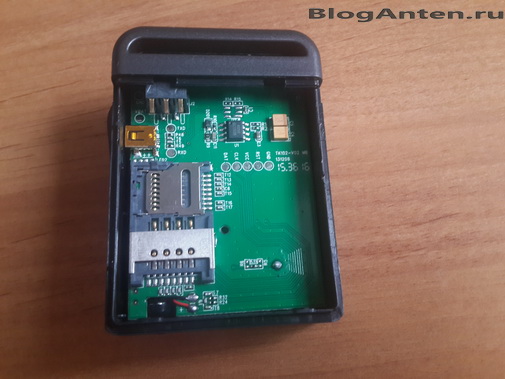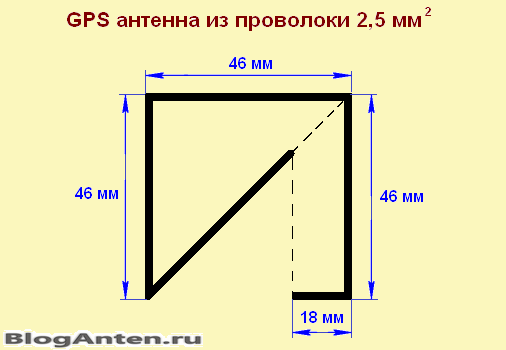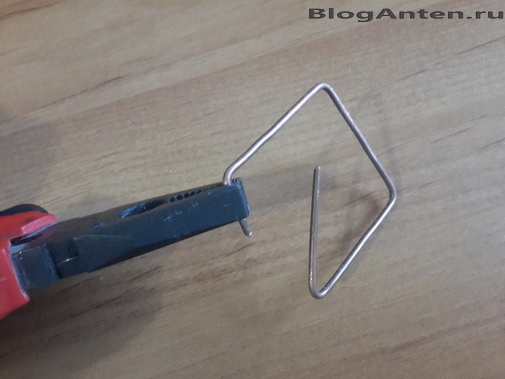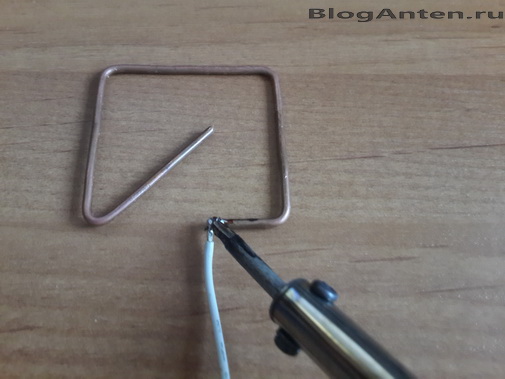Nowadays, satellite navigation is an integral part of everyday life, GPS is built into all mobile devices... Navigators and trackers working with GPS or domestic Glonass are becoming more widespread, mainly in vehicles, cars, etc. When working with various GPS gadgets, you often have to deal with a weak GPS signal or its complete absence. Today we will consider how you can strengthen the GPS signal in devices that work with it.
We will mainly talk about the antenna, but not just about the antenna that you can buy in the store, but about homemade GPS antenna, which can be connected to any device with a GPS module. This antenna, or rather how to make it, was told to us by a regular blog reader, Yuri from Tambov, who, in turn, dug up this circuit at some American forum, for which many thanks to him.
The antenna was manufactured and tested by me, despite the fact that it turned out the second time, I fully confirm the efficiency of this design. An antenna was made for the Chinese, which suffered from a constant loss of signal from GPS satellites. It is known that this is the main problem with cheap trackers, there are weak GPS modules, which have a patch on the body of the module as an antenna. Such a module will work only under the open sky, if you hide the device somewhere (under the hood of a car, for example) and the signal is immediately lost.

Before starting to manufacture a GPS antenna, it is worth making sure that you can get to the GPS module, to which the antenna will be connected. In a Chinese tracker, getting to the GPS module is not difficult, everything is well understood and assembled there, the photo below shows what the GPS module looks like on the tracker. It looks, in principle, almost the same on all devices, be it a tracker or a navigator. But if it is easy to get to it in the tracker, then in the navigator with disassembly problems may arise, since the device is more complicated. Therefore, be sure to make sure whether it is worth disassembling your device if you do not know exactly how to do it. In addition, it is better to connect a commercially available external antenna to the connector of the device, if such a connector is available.

In ordinary, inexpensive GPS trackers, there is no such connector. So the home-made revision is quite justified. What is good about this antenna is that it is easy to manufacture, and has a miniature size, it is a square 46 by 46 mm. The antenna is made of 2.5 mm 2 copper wire. This is a regular monolithic electrical wire which is used in electrical wiring.
Photo of making a GPS antenna

![]()

The very process of making a GPS antenna is shown in detail in the photo. The point lies in the correct bending of the wire according to the dimensions indicated in the diagram. The wire is easily bent by hand using pliers. It is imperative to maintain all dimensions exactly, the performance of the structure depends on it.


After making the antenna itself, it will need to be soldered to the patch on the GPS module as shown in the photo. Under no circumstances should the GPS module be confused with a GSM antenna, the GSM antenna is displayed separately on the tracker in the form of a small circuit. The GPS module is soldered to the device board. Further, the whole structure is assembled, and homemade antenna soldered with a small piece of wire, which is inserted into the body through a specially made hole. The antenna itself can be attached to the tracker body with ordinary tape.

The result of such a refinement was immediately noticeable, the tracker catches satellites even indoors, before that it refused to do this even on the window. A stable GPS signal is now provided in almost any conditions, which is very important for the tracker. Such homemade gps the antenna will fit any GPS device, the main thing is to get to the module. But the main advantage of this design is that anyone can make such a simple GPS antenna with their own hands.


All modern tablets and smartphones have built-in GPS, but they cannot be compared to full-fledged navigators. Gadgets cannot always catch satellites in difficult conditions reception. This happens in different conditions:
- The glass in the car is coated with a special coating that impairs signal reception.
- The tablet cannot be placed under the windshield.
- Limited visibility - this refers to special equipment.
But there is an easy way to get your tablet as close as possible to a full-fledged navigator - to install an external GPS antenna. Some motorists turn to service centers, but why pay if you can do the work yourself.
Reference! The external antenna is housed in a compact box, the size of which usually does not exceed half a matchbox. A shielded cable comes out of the box, its length depends on the model, but usually the cable is 3-3.5 meters. A special connector located at the end of the cable connects to signal receivers, in our case, to the tablet. Also, the antenna can be connected to a smartphone or computer.
Installation process
When choosing an antenna, you need to explain to the seller for which device the GPS signal booster will be used. Modern models can connect not only via USB, but also via Bluetooth. And now to the connection:
- The ideal solution for your smartphone is a GPS antenna that connects to the device via Bluetooth. All data will be transmitted over the protocol. The advantage is that you don't need additional connectors and modifications.
- Due to the fact that the navigation application is already present on the tablet, you do not have to enter new parameters.
- Also, the external receiver can have a USB / PS2 connector. Such an interface is commonly used personal computers, laptops, but there are exceptions. As in the first case, you only need to connect the antenna to the device.
Rarely, but there are tablet models where there is no USB input. In this case, it is worth purchasing an external GPS Bluetooth antenna. The increased efficiency of such an antenna can be explained by the presence of an autonomous power source. It is also important to secure it correctly. Some motorists carry it to the roof, others attach the modifier under the glass. In any case, with an external GPS antenna, your tablet will perform just as well as a separate navigator for a car.
Yesterday evening they put Samsung Galaxy s1 + and my Dafi + next to it. Obviously, no a-gps (it's useless in the mountains anyway).
Dafy calculated for a long time, about 2-3 minutes, the chip is not fast, but I normally saw the satellites and gave the coordinates to the programs.
Sams somehow saw satellites, and in sufficient numbers, but did not give out the coordinates, although we waited a long time. City center, Aleksandrovsky prospect, near Grecheskaya square, those. there is no question of any total screening by high-rise buildings. As a result, in Samsa, the software just went to search for cell phones.
Advantages of an external gps receiver:
1) the flair is better (a normal external one has a decent antenna, for example, my iBlue-747 rev.B).
2) starts faster.
3) the smart battery sits down less, maybe. BT interface eats several times less than internal gps.
Minus - communication via BT is interrupted from time to time, and in some programs the recording of the track will be interrupted.
One problem - until now, almost all navigation programs for Android are able to use only the GPS receiver built into the phone. Android 2.3.x also does not know how to work with external receivers.
In WinMobile, a mature system, all this was - already a simple gps proxy was built into the 6-ku, which made it possible to connect any compatible external receiver, sit on any port and broadcast its data to 1 or several programs. And besides him there was a very functional gpsGate, which does the same thing + a bunch of add-ons. The programs also had a standard receiver selection option.
In android, support for external receivers in the OS is not implemented, at least in 2.3.x, and manufacturers of navigation software are simply too lazy to write something separate for this (while paid ones do not become cheaper).
Typical, from the forum "Until you wait until the internal one works, I would have traveled a thousand times, and I feel sorry for the battery"
For the Robot developers, the need for such a thing at the system level will be clear somewhere by version 4.5, apparently. And that's not a fact.
But there are craftsmen who have written programs that replace the internal GPS of the phone with an external one. A typical navigation program does not know that it is communicating with the outside, thinking that it is communicating with the inside.
Important note. It cannot be guaranteed that any of these programs will work correctly on all versions of Android, and with all navigation programs.
Check it out. (I now have an improved (by craftsmen) firmware from Motorola based on Android 2.3.4)
For both programs to work, you need to enable the developers option "enable mock locations".
Note. In most combinations of a proxy emulator and a navigation program in the actual navigation program you will not see satellites.
The program works correctly, gives coordinates to 2 programs at the same time, but some of the programs receive a signal, and at the same time gives out that gps is disabled (in general, it is true for the system chip), if I did not turn on the system gps.
Or you can turn on the system one - it will replace it.
Shows (succinctly and clearly) satellites and data from the receiver.
Many options, support for various external receiver chips (including the most popular ones, SiRF III / MTK)
So far, I like it more than the 2nd.
The program works correctly, gives coordinates to 2 programs at the same time, but you need to enable Gps in the system options - otherwise it will not work.
Only a hard substitution of the system gps works.
There are options for siRF III.
The program is periodically updated.
Quite suitable, but 1st is better.
Tablets are constantly incorporating the functions of different gadgets. Navigation is no exception. Almost a few years later, after the appearance first iPad, appeared a tablet navigator with a GPS module on board. Then navigation services and specialized programs appeared.
First you need to figure out what is actually better - a tablet navigator or a navigator, as a separate gadget. Here opinions are divided into two camps. Some argue that a standalone device performs better, is more responsive and navigates faster. Fans of tablet PCs are sure that All-in-one is much more functional, because besides the GPS itself, there are others in the device. useful functions and programs. It supports all video formats, internal memory more, the display itself is also larger. So which is better? Navigators (standalone devices) or tablets with GPS navigation? The choice remains with the consumer, but before that, let's compare the advantages and disadvantages in a broader form.
Pros of a tablet in a car
- The ability to mount a huge display up to 12 inches. Navigators use (standard) 7 inches. But magnitude does not play the first role. The most valuable thing is permission. With a high value of the latter, video and other media content works much more revealingly, it is much more convenient to surf the Internet and more comfortable to play games.
- In a tablet PC, the Internet is used not only for entertainment and work, but also directly for navigation. So, when the Internet is connected, you can use the A-GPS technology, which will speed up the work of your module. The most interesting thing is that you can see traffic jams, accidents and similar information. Moreover, the data is automatically constantly updated.
- Powerful filling. Almost any tablet beats the navigator with its technical characteristics... For example, the navigation program Navitel is very demanding. Although ordinary navigators cope with it, they are slow. An average tablet does this without any problems, performing other functions and tasks in the background.
- Computer functions. On the tablet, you can speak on Skype, play, as mentioned above, media content, surf the Internet. Much of this is already available in navigators, but a lot of things are never implemented there. For example, the ability to run office applications for working with documents, install specialized programs, and so on.
- Operating system. Basically, it's Android, but on Apple devices and Windows gadgets also have navigation for the tablet. The bottom line is that the system is flexible and you can completely and completely customize it for yourself, which you cannot do with the navigator.
- Tablets always have more powerful battery, since it was created for autonomous work, while the navigator was designed to work on a trickle charge, although it has its own battery as well. This is especially important in extreme conditions.

Cons of a tablet in a car
- Fixing the device. All navigators come with a mount, while for tablets you will have to buy it separately and make it yourself. It is worth noting that expensive tablets have their own original mounts. About how best to install the tablet in the car, we.
- Screen. Not everyone will benefit from a large tablet display. Some will find it very bulky, covering up a large section of the windshield and creating the effect of a piled-up car.
- GPS modules. When developers install a GPS receiver for a tablet, they save on chips. Accordingly, it is weaker in comparison with GPS - a separate device. This does not only apply to the giants of the market - Apple and Samsung.

Tablet Navigator: Video
External GPS module for tablet
So, if you decide to install a tablet on your car, you should know that not all devices are equipped with this module. What should be done in this case? The easiest way is to buy a separate external GPS-module for the tablet. By the way, the latter completely replaces all the disadvantages of built-in modules. He sees many more satellites (even indoors) and connects to them faster. But the device also has a drawback. It is powered by a tablet and uses Bluetooth technology, that is, two modules will be turned on in the tablet at the same time, which drains the battery quite a lot. The only good news is that there are no problems with recharging in the car.




